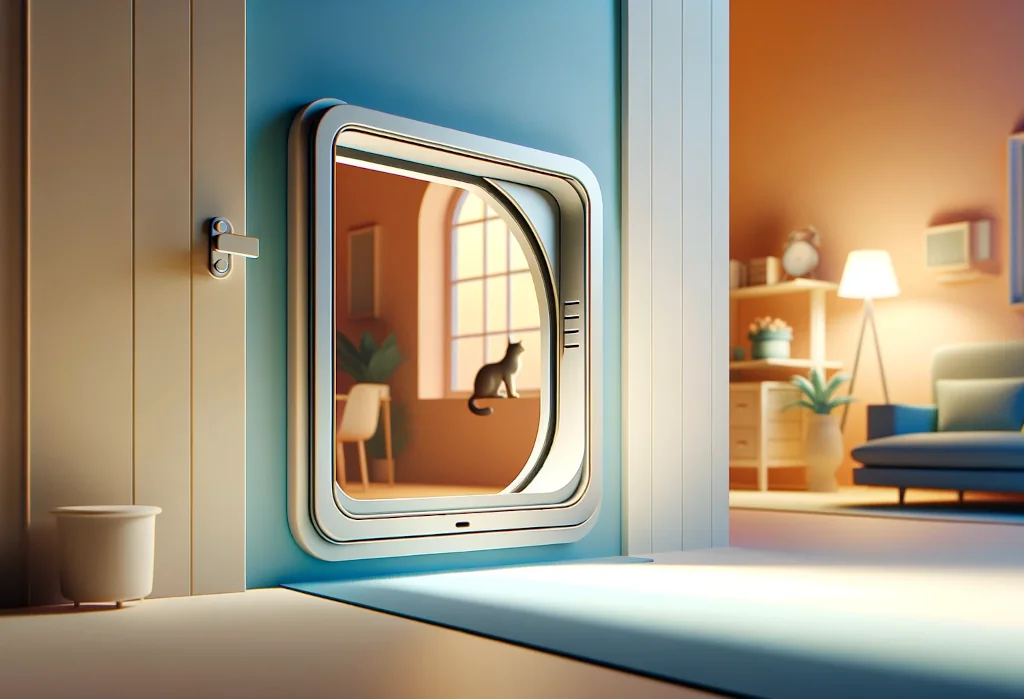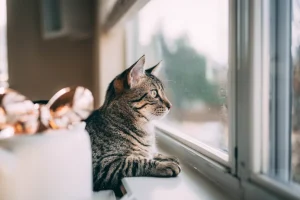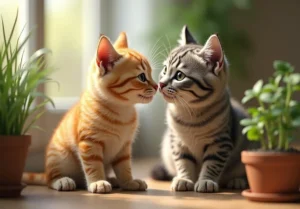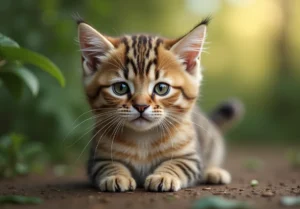Disclosure: We may earn a commission from helpful, relevant links in our content. No cost to you. See our privacy policy.
Ah, cats. Notoriously adventurous and famously nine-lived. But when it comes to the safety of our feline friends at home, those nine lives feel a tad less comforting, don’t they? These little explorers have a knack for finding the one thing in the house they shouldn’t.
By the end of this post, you’ll be well-equipped to cat-proof your home, ensuring a safe haven for your curious companion. Let’s make their exploration a joy, not a jeopardy!

Quick Takeaways:
- Invest in cat-safe window guards and opt for pet-friendly cleaning products to secure indoor spaces.
- Identify and eliminate toxic plants; offer cat-approved greens like catnip or cat grass instead.
- Equip your home with sturdy, large cat toys and scratchers to prevent destructive behaviors.
What Can You Do to Prevent Falls From Windows?
Let’s tackle head-on a concern that’s given many a cat owner a few gray hairs – keeping your curious feline safe from the dangers of open windows. It’s no secret that cats have a penchant for perching on high spots, making windowsills an irresistible allure. However, without the right safety measures, this can lead to accidental falls. So, what’s the game plan?
Secure Your Windows with Cat-Safe Guards
First things first: Invest in sturdy window screens or guards. These aren’t your run-of-the-mill screens but are specifically designed to withstand the antics of your adventurous furball. A quick Google search for “cat-safe window guards” will pop up several options, but for starters, look into products like Flat Cats and Safety 1st. Both offer solutions that allow fresh air in while keeping your cat safely inside.
Unique Tip:
Consider installing a Transparent Polycarbonate Shield on windows you frequently open. Unlike traditional screens, these shields offer an unobstructed view and are nearly indestructible – perfect for those feline acrobats. Plus, they’re a godsend for preserving the aesthetics of your home.
How Do You Keep Your Cat Away from Toxic Plants?
Our green friends are a fantastic way to spruce up our homes, but did you know many common houseplants are no-nos for our whiskered companions? Cats, driven by curiosity, might nibble on leaves, leading to potential health risks. Here’s how to keep the peace in your indoor jungle:
Know Your Plants
A little homework goes a long way. Familiarize yourself with which plants are feline-friendly. Spider plants, Boston ferns, and African violets are all safe bets. If you suspect your cat has ingested a toxic plant, the ASPCA’s Animal Poison Control Center ([ASPCA APCC]) is a crucial resource.
Strategic Plant Placement
Elevate plants onto high shelves or hang them from the ceiling – spots your cat can’t easily reach. Moreover, consider distracting your cat with catnip or a small indoor cat grass garden, which can be more appealing than your decorative plants.
Safe Play: Keeping Toys and Small Objects Out of Reach
Turning our homes into a cat-proof playground requires some creativity and attention to detail. Cats have a knack for turning anything and everything into a toy, but certain items can pose choking hazards.
Opt for Large, Indestructible Toys
When shopping for toys, size matters. Select toys that are too large to be swallowed but still allow for engaging play. Also, durability is key. Toys made from sturdy materials can prevent them from breaking into smaller, hazardous pieces. Products like KONG’s Kickeroo offer long-lasting entertainment without the risk.
DIY Toy Storage
Get creative with storage solutions. A simple basket on a high shelf or a dedicated drawer can keep small items out of paw’s reach. Not only does this keep your cat safe, but it also helps declutter your space.
By taking these proactive steps, you can create a safer environment for your feline friend. Whether it’s securing windows, choosing safe plants, or selecting the right toys, each measure adds up to a happier, healthier cat. Keep an eye out for the next sections where we’ll delve even deeper into making your home the ultimate cat haven.
Chemicals and Cleaners: A Hidden Hazard?
When it comes to cat safety within the walls of your home, household cleaners and chemicals stand out as stealthy adversaries. These commonplace items, while effective at keeping our homes spick and span, can pose a significant risk to our feline friends if not stored and used responsibly. But fret not! With a few adjustments, you can ensure a safe environment for your curious cat.
First and foremost, always store poisonous items—like bleach, ammonia, and toilet bowl cleaners—in secured cabinets that are inaccessible to your cat. Cats are known for their agility and ability to climb, so consider installing child-proof locks to outsmart even the most Houdini-like felines.
Next, opt for pet-friendly cleaning alternatives. Many brands offer cleaning products that are safe for pets, using natural ingredients that won’t harm your cat if they come into contact with treated surfaces. For example, baking soda, vinegar, and lemon juice can tackle many household cleaning tasks without the use of harsh chemicals.
What most bloggers might not tell you, and this is our unique slice of advice, is to establish a “cleaning cupboard audit” schedule. Once every three months, take stock of what’s in your cleaning supplies. It’s not just about checking what products are pet-safe, but also ensuring that any toxic items haven’t been inadvertently left within reach or have spilled and gone unnoticed. It’s all too easy for a small spill of a harmful chemical to remain under a sink, going undetected until it’s too late.
Is Your Furniture Cat-Friendly?
Now, let’s talk about making your furniture cat-friendly, since our beloved feline companions are known for their tendency to climb, scratch, and occasionally take the leap of faith from heights that would make even an adrenaline junkie think twice.
To minimize risks and cat-proof your home, consider the following tips:
- Secure heavy furniture to the wall . Cats love to explore, and their climbing escapades can lead to heavy objects tipping over. Use furniture anchors to secure bookcases, dressers, and shelves, providing peace of mind that your cat’s adventure won’t end in disaster.
- Offer alternatives to your couch for scratching. Invest in a variety of scratchers—vertical, horizontal, and angled—to cater to your cat’s preferences. Placing scratchers next to furniture can deter them from using your favorite sofa as their personal manicure station.
- Create “cat-approved” spaces. Cats love to observe their domain from high vantage points. Installing cat shelves or purchasing a tall cat tree can satisfy their climbing instincts in a safe manner. Ensure these are stationed away from breakable items and have a sturdy base to prevent tipping.
- Avoid glass-top tables if possible. These can serve as precarious platforms for cats, posing a risk of breakage and injury. Instead, opt for solid tabletops that can safely support a cat’s weight.
- Employ cat-friendly upholstery. Consider materials that are less appealing to cat claws, like microfiber, which also has the added benefit of being easy to clean.
A specific example of creating a cat-friendly environment includes using double-sided tape on areas of furniture where a cat might be tempted to scratch. The sticky sensation discourages scratching behavior, naturally guiding them towards more appropriate scratching outlets like their designated scratchers.
Remember, making your home cat-friendly doesn’t have to come at the expense of style or convenience. With these thoughtful adjustments, you can create a space that caters to both your and your cat’s needs, ensuring safety, comfort, and harmony within your household.
Alex, a passionate animal lover, has experience in training and understanding animal behavior. As a proud pet parent to two dogs and three cats, he founded AnimalReport.net to share insights from animal experts and expand his knowledge of the animal kingdom.




